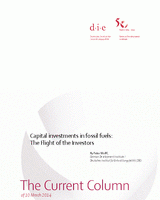Capital investments in fossil fuels: The Flight of the Investors
Wolff, PeterThe Current Column (2014)
Bonn: German Development Institute / Deutsches Institut für Entwicklungspolitik (DIE) (The Current Column of 10 March 2014).
Bonn, 10.03.2014. Economists and climate politicians agree that a price for CO2 emissions would be the best instrument to reduce emissions and steer investors towards investments in low-carbon energy production, but this is still a long way away. Because the majority of past investments are tied into fossil energy production – bituminous coal, lignite, gas and mineral oil – the owners of these investments have a natural tendency to oppose a reduction of the massive subsidies that go into fossil fuels which, according to the International Energy Agency (IEA) rose to a record level of 544 billion US dollars in 2012. Not to mention the acceptance of a price for CO2 emissions.
The G20 countries reached an agreement in 2009 to reduce the subsidies for inefficient fossil energy sources. Since then, every G20 country has had to report on how it is reducing its fossil fuel subsidies, but not much has happened up to now. Even at the impending decisive climate conference in Paris in 2015, it is not to be expected that subsidies will be reduced and a price for CO2 emissions agreed. To make matters worse, the EU market for CO2 certificates practically collapsed last year too.
If subsidies were actually to be reduced and a price for CO2 emissions agreed, the capital tied into fossil energy sources would be devalued, however, as it is currently the case with several German energy concerns whose value has dropped rapidly due to Germany’s energy transformation. Only last week, Germany’s second largest energy supplier RWE reported a loss of 2.8 billion euros for 2013 with the corresponding effects on the share price.
This has caused long-term investors to prick up their ears. What will happen to capital that has been tied up for decades if there is to be a price for CO2 emissions in 10 or 20 years because global warming will have reached crisis level by then? While this continues to be discussed in political circles, large corporations and long-term investors are beginning to take action.
Many large companies are already including a price for CO2 in their long-term investment plans. For these firms, it is a dictate of risk management to include probable future developments in their plans in order to avoid bad investments. Large oil companies like Exxon Mobil also calculate with these “shadow prices” which, according to the Economist, will amount to 60 US dollars per tonne of CO2 from 2020. It seems fairly obvious, therefore, that prices of this kind, which reflect the damage caused by CO2 emissions better than the current market prices, will change investment behaviour as well as the value of the capital that is tied in to fossil energy sources.
The large investment funds, which invest their capital over long periods and expect consistently positive returns, have realized this too in the meantime. They are also anticipating the inevitable long-term depreciation of the value of fossil fuels and are restructuring their investment portfolios accordingly. To begin with, it was the “ethical” investors, such as a few American families and college foundations, who sold off their shares in energy companies for climate policy reasons. In the meantime, however, it is also US pension funds worth billions of dollars who are gradually changing their investment strategy.
These may only be pinpricks initially for the big energy companies, whose value on the stock exchange will hardly change, but the pressure is starting to build. The sovereign wealth fund in which Norway invests its oil revenue for future generations, is considering changing its investment strategy away from coal, oil and gas. We are talking about 840 billion US dollars here, a large portion of which is tied up in fossil fuels. A group of experts has now been commissioned by the Norwegian Parliament to prepare a report on the long-term further development of these investments.
It can be seen that a lot of things are moving in the right direction below the level of global climate policy agreements, which are hardly achievable at the moment. Private companies are reacting quicker than politics and are beginning to adapt to a “decarbonized” future for reasons of pure profit and risk considerations. It is high time too that state-run development banks which finance investments in energy production – from the KfW and European Investment Bank to the World Bank – agree an obligatory “shadow price” for the CO2 emissions from energy projects which they can calculate into their project analyses. They should at least plan as far ahead as Exxon Mobil.
